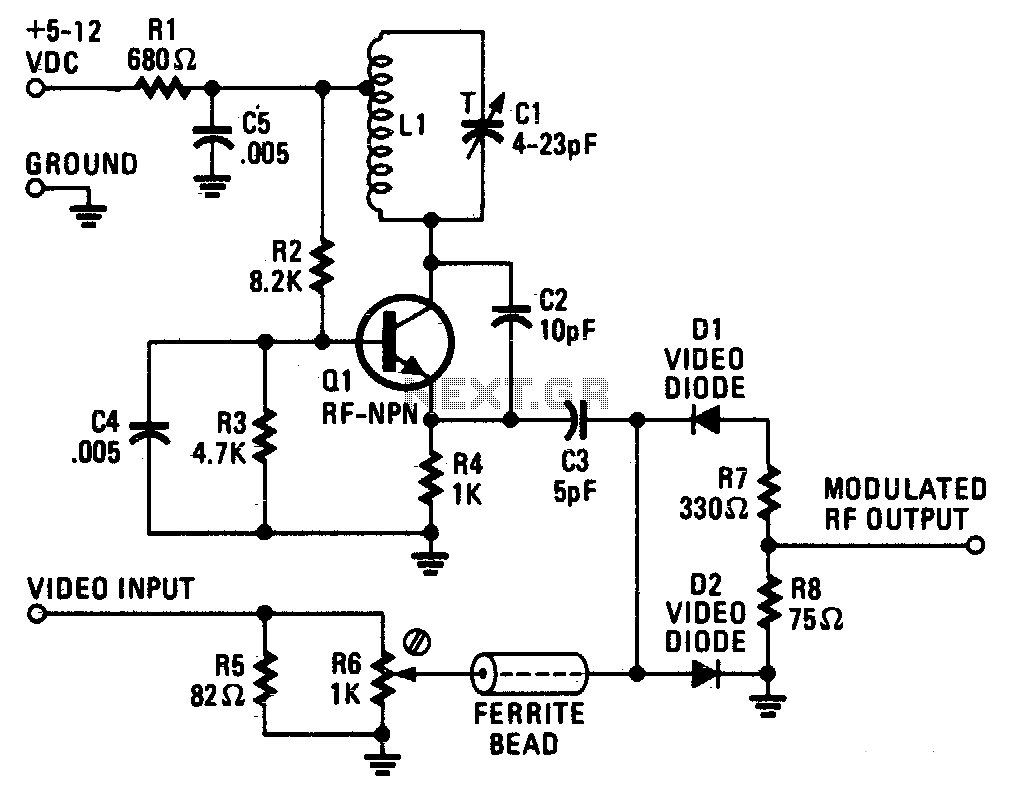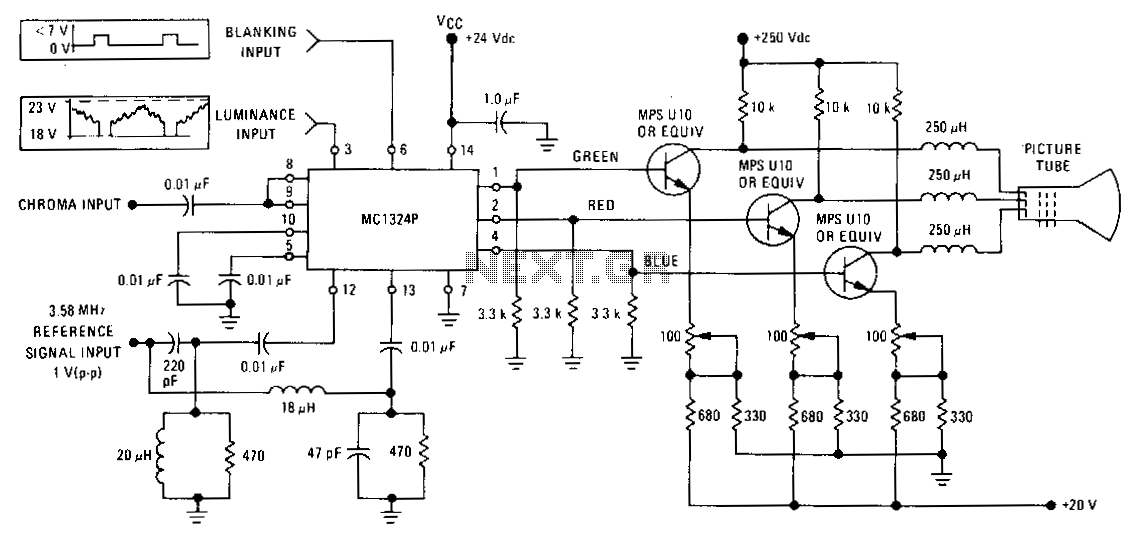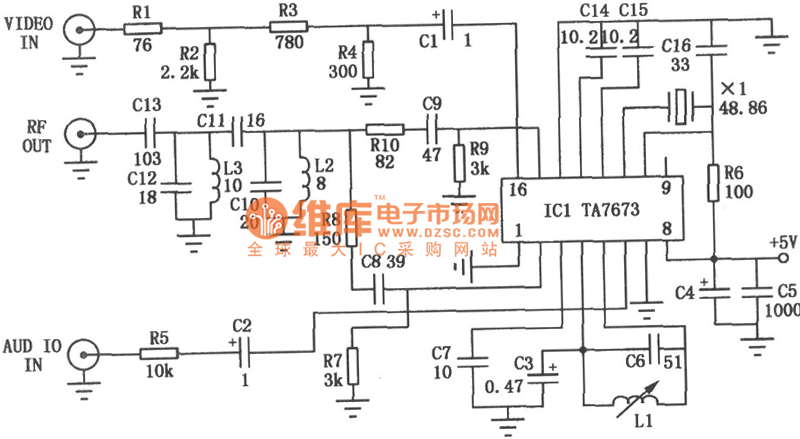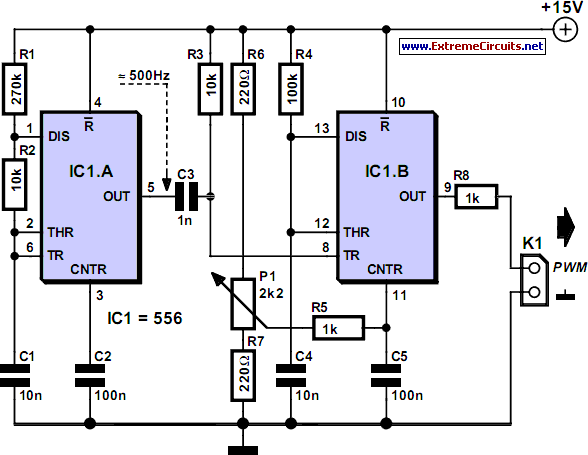
Tv modulator

The VHF frequency is generated by a tuned Hartley oscillator circuit. Resistors R2, R3, and R4 bias the transistor, with a tapped inductor L1 and trimmer capacitor C1 forming the tank circuit. Adjusting C1 determines the frequency. Capacitor C2 provides positive feedback from the tank circuit to the emitter at Q1. Capacitor C4 provides an RF ground for the base of Q1. Bypass capacitor C5 and resistor R1 filter out the radio frequencies generated in the tank circuit to prevent radiation from the power supply lines. The video signal enters the parallel combination of resistors R5 and R6; this combination closely matches the 75-ohm impedance of most video cables. Resistor R6 is a small screwdriver-adjusted potentiometer used to control the video input level to mixer diodes D1 and D2.
The described circuit employs a tuned Hartley oscillator to generate VHF frequencies, which are critical in various communication applications. The oscillator consists of a transistor, typically a bipolar junction transistor (BJT), which is biased by resistors R2, R3, and R4. The configuration of these resistors ensures that the transistor operates in the active region, enabling efficient amplification of the oscillation signal.
The tank circuit, composed of the tapped inductor L1 and the trimmer capacitor C1, plays a crucial role in determining the oscillation frequency. The trimmer capacitor allows for fine-tuning of the frequency output, facilitating adjustments based on specific application requirements. Capacitor C2 is strategically included in the design to provide positive feedback, enhancing the oscillation process by feeding back a portion of the output signal to the emitter of transistor Q1.
Capacitor C4 serves as an RF ground for the base of Q1, which is essential for stabilizing the oscillator's operation and minimizing unwanted noise. The inclusion of bypass capacitor C5 and resistor R1 is critical for filtering out any unwanted radio frequency interference that may be generated within the tank circuit. This filtering prevents potential radiation from affecting the power supply lines, thereby ensuring the integrity of the circuit's performance.
The video signal processing section of the circuit utilizes a parallel combination of resistors R5 and R6 to achieve impedance matching with standard 75-ohm video cables. This impedance matching is vital for minimizing signal reflections and ensuring optimal signal transmission. Resistor R6, configured as a small screwdriver-adjusted potentiometer, allows for precise control of the video input level before it is fed into the mixer diodes D1 and D2. This arrangement facilitates effective mixing and processing of the video signal, contributing to the overall functionality of the circuit in video applications.The VHF frequency is generated by a tuned Hartley oscillator circuit. Resistors R2, R3, and R4 bias the transistor, with tapped inductor LI and trimmer capacitor Cl forming the tank circuit. Adjusting Cl determines the frequency. Capacitor C2 provides positive feedback from the tank circuit to the emitter at Q1. Capacitor C4 provides an RF ground for the base of Ql. Bypass capacitor C5 and resistor Rl filter out the radio frequencies generated in the tank circuit to prevent radiation from the power-supply lines
The video signal enters the parallel combination of resistors R5 and R6; this combination closely matches the 75 ohm impedance of most video cables. Resistor R6 is a small screwdriver-adjusted potentiometer that is used to control the video input level to mixer diodes Dl and D2.
🔗 External reference
The described circuit employs a tuned Hartley oscillator to generate VHF frequencies, which are critical in various communication applications. The oscillator consists of a transistor, typically a bipolar junction transistor (BJT), which is biased by resistors R2, R3, and R4. The configuration of these resistors ensures that the transistor operates in the active region, enabling efficient amplification of the oscillation signal.
The tank circuit, composed of the tapped inductor L1 and the trimmer capacitor C1, plays a crucial role in determining the oscillation frequency. The trimmer capacitor allows for fine-tuning of the frequency output, facilitating adjustments based on specific application requirements. Capacitor C2 is strategically included in the design to provide positive feedback, enhancing the oscillation process by feeding back a portion of the output signal to the emitter of transistor Q1.
Capacitor C4 serves as an RF ground for the base of Q1, which is essential for stabilizing the oscillator's operation and minimizing unwanted noise. The inclusion of bypass capacitor C5 and resistor R1 is critical for filtering out any unwanted radio frequency interference that may be generated within the tank circuit. This filtering prevents potential radiation from affecting the power supply lines, thereby ensuring the integrity of the circuit's performance.
The video signal processing section of the circuit utilizes a parallel combination of resistors R5 and R6 to achieve impedance matching with standard 75-ohm video cables. This impedance matching is vital for minimizing signal reflections and ensuring optimal signal transmission. Resistor R6, configured as a small screwdriver-adjusted potentiometer, allows for precise control of the video input level before it is fed into the mixer diodes D1 and D2. This arrangement facilitates effective mixing and processing of the video signal, contributing to the overall functionality of the circuit in video applications.The VHF frequency is generated by a tuned Hartley oscillator circuit. Resistors R2, R3, and R4 bias the transistor, with tapped inductor LI and trimmer capacitor Cl forming the tank circuit. Adjusting Cl determines the frequency. Capacitor C2 provides positive feedback from the tank circuit to the emitter at Q1. Capacitor C4 provides an RF ground for the base of Ql. Bypass capacitor C5 and resistor Rl filter out the radio frequencies generated in the tank circuit to prevent radiation from the power-supply lines
The video signal enters the parallel combination of resistors R5 and R6; this combination closely matches the 75 ohm impedance of most video cables. Resistor R6 is a small screwdriver-adjusted potentiometer that is used to control the video input level to mixer diodes Dl and D2.
🔗 External reference





